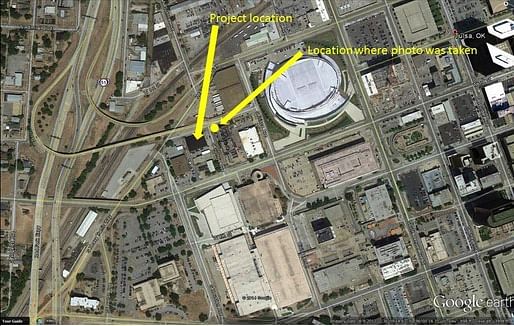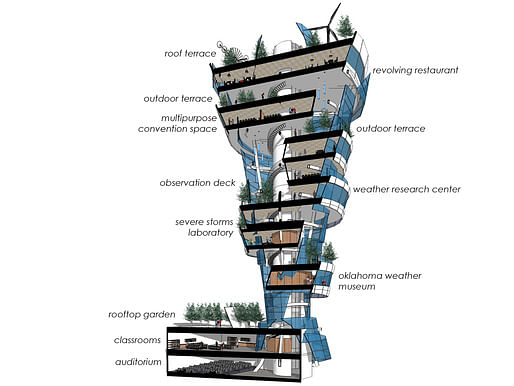
An old two-story warehouse on 202 S. Guthrie may appear as just another underdeveloped property for people driving through the streets of downtown Tulsa, Oklahoma. But for locally based Kinslow, Keith & Todd architects, the current 28,000 sq.ft parking structure has enough potential to become the base for a funnel-shaped tower dubbed as the "Tornado Tower."
Considering that Tulsa has a fairly long history of tornadoes, a tornado-shaped tower may not seem so outlandish. KKT architects conjured up the Tornado Tower for Tulsa People magazine's recent "Reimagining downtown" article, which states that KKT wanted to design an iconic Oklahoma-themed building that would open up people's perspectives on buildings and of Tulsa. While some may see it as an ideal space for weather forecasting and research purposes, the tower would surely attract plenty of tourism to the city.



And rightly so. Located near the BOK Center and Cox Business Center, the 250-300 feet tall mixed-use tower would consist of the Oklahoma Weather Museum and Research Center, additional educational spaces and weather-research labs, observation decks for weather forecasting, and -- to top it all off -- a revolving restaurant/bar that offers a 360-degree view of the Tulsa skyline at some 200 feet in the air.

The glass-clad tower would also be built with perforated metal panels accented with LED lights to give the illusion that the building is turning as people drive past it. The nondescript warehouse as the tower's base would then be renovated into a classroom and auditorium, as well as a rooftop garden that would teach visitors about native Oklahoma grasses and plants. But with all that said, could the tower withstand a real tornado? Well, the tower would have to be built to find the answer to that.
What are your thoughts of the Tornado Tower? Folly or clever?
22 Comments
Where's Auntie Em's house? That's what it needs.
Love the suggestion of airborne debris in the rendering.
The avant garde is rapidly approaching the Wall of Terminal Wierdness.
Just what Tulsa needs: a building that emulates a cyclonic storm cloud of death.
Maybe a tornado resistant trailer would be a better response.
Just what Tulsa needs: a building that emulates a cyclonic storm cloud of death.
Just think of it as a new paradigm for promotional development, and imagine the Freedom Tower designed around this concept. Or New Orleans, or Fukushima, etc.
Hey, let's go to the new Sievert Tower by BIG!
offensive and tone deaf.
How is it offensive? Because people have been killed by tornadoes? We accept branding using sharks, tigers, Vikings, and other deadly things. Tornadoes are a fact of life in Oklahoma, using them as a regional reference is not equivalent to celebrating a man made disaster like the ones Miles mentioned.
When I first clicked on the article, I was prepared to think that it was a pretty dumb idea, but it grew on me. Sure, its kitschy, but I think that it might be just the thing.
Not sure that the Tulsa skyline would be interesting to look at for more than a single revolution of the restaurant, though.
Freedom tower v.2.0:
EKE, I think thats a fascinating project because of the way the public responded to it. With all the discussion about public relations in architecture, it almost seems like "public relations nightmares" are the only projects that can evade the charge of pandering or managing perceptions.
Restating a problem does not really solve it. The world trade center competition should have been about making a safer tall building and this building should have been about making a tornado resistant one.
I appreciate symbolizing in form and space as well as the next designer (John Hejduk is my favorite Architect), but this is completely wrong headed in my opinion.
At least to my way of thinking, a tasteless exercise in lack of empathy for those who have lost family and friends in these disasters.
Apparently, these "architects" have as much humanity as they do knowledge of structural engineering.
The MVRDV building is a very interesting project, for all of the reasons you mentioned. I think that it also clearly demonstrates what can happen when architecture rejects cultural archetypes in favor of super-novel form. You can't control what associations people will make, and those associations will not always be the ones you expect or want.
I immediately thought about this project when I saw the Tulsa tornado building, and I went to the MVRDV website to try to grab an image. They have taken if off the site. :)
EKE, I'm not sure I agree about the archetype thing because essentially its just two towers with a bridge between. The problem was with the "cloud" aesthetic juxtaposed with towers. If it were just a straight bridge, it would look like the letter H, not 9-11. But it shows how the public interprets images that are circulated on the internet. Its quite possible that the actual built design in real life would've not looked like 9-11.
MVRDV actually had an apology on their website during the controversy. I screen captured it and still have it on my computer.
In a real tornado situation that airborne debris would be this tower.
How the hell is this going to resist the stress of an EF 5 tornado. If you are going to propose a massive structure in tornado alley, you are going to need to engineer it to the largest tornado's stress magnitude by a factor of 10 so there is no failure. Even the weakest part must be able to resist the load induced by a tornado 10x the level of a EF5 tornado. Mach 5 wind shear stress load.... or build it underground.
I still find it very hard to believe that the similarity between the MVRDV building and the WTC buildings and 9/11 was coincidental, despite their protestations. Aside from the "cloud" bridge, the geometry, proportion, orientation of the two towers is so obviously similar that it's hard for me to imagine this having been unintentional.
"I still find it very hard to believe that the similarity between the MVRDV building and the WTC buildings and 9/11 was coincidental"
So do I. There was also a smaller controversy years earlier when they proposed a house for the Make It Right effort in the Lower 9th Ward that appeared to be broken in half. It seemed to some like a cheeky reference to hurricane damage.
Seems like MVRDV is practicing reverse public relations or maybe public antagonism.
I think both examples are really cynical.
using them as a regional reference is not equivalent to celebrating a man made disaster like the ones Miles mentioned.
New Orleans / Katrina was man made?
Miles - from Time Magazine, which is about as cautious a source as you're likely to find - "It took a while, but the prevailing narrative is finally starting to reflect that Katrina was a man-made disaster, not a natural disaster, triggered by shoddy engineering, not an overwhelming hurricane."
Balkins- With the exception of nuclear power plants, nothing is designed to survive a EF5 tornado - EF3 "severe" can have wind speeds up to 165mph. EF4 ="devastating" EF5="incredible".
I suppose any natural disaster is man-made if you figure that it wouldn't be a disaster if there weren't any people around. Which would make hurricane Sandy man-made too.
To comment on the MVRDV discussion...
I wouldn't be surprised if these ideas are connected, but not intended for external observation.
There is a lot of inspiration for the design of projects that is never meant to be symbolic or even noticeable at all.
natematt,
I believe that is true, however, certain associations should be taken into account when one sees what one comes up with. Some symbolism is so toxic as to be radioactive.
Block this user
Are you sure you want to block this user and hide all related comments throughout the site?
Archinect
This is your first comment on Archinect. Your comment will be visible once approved.